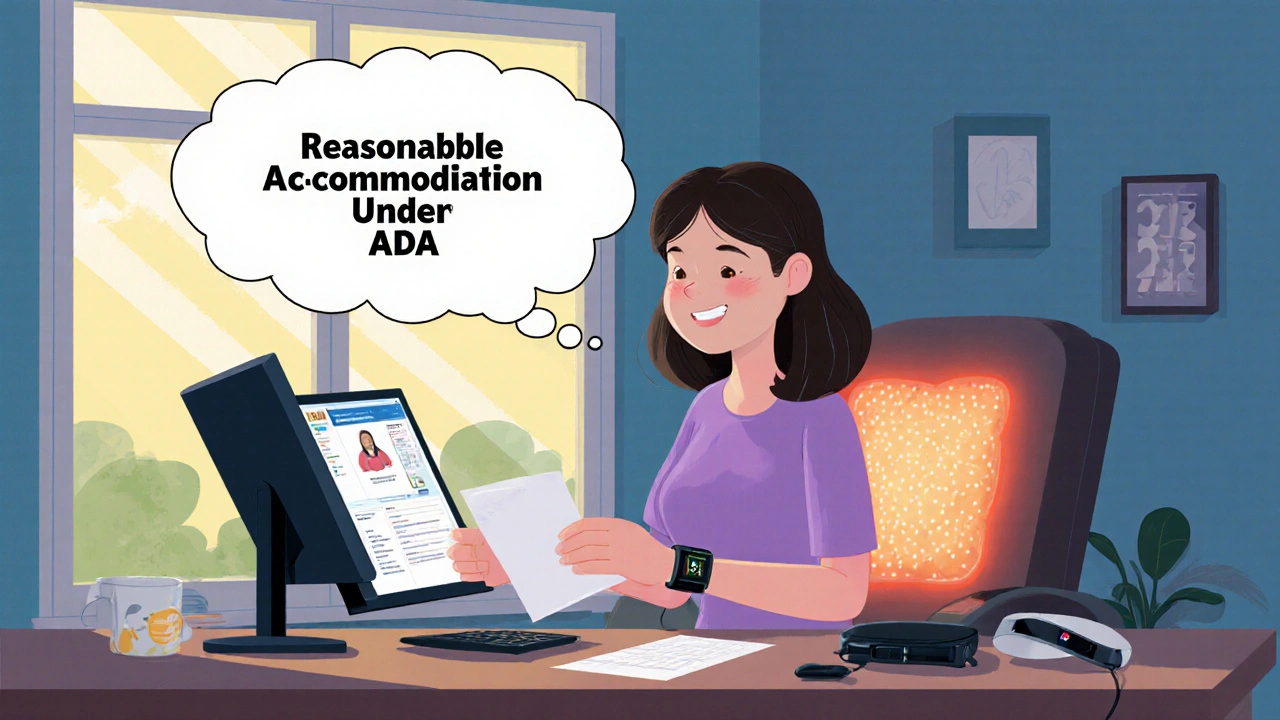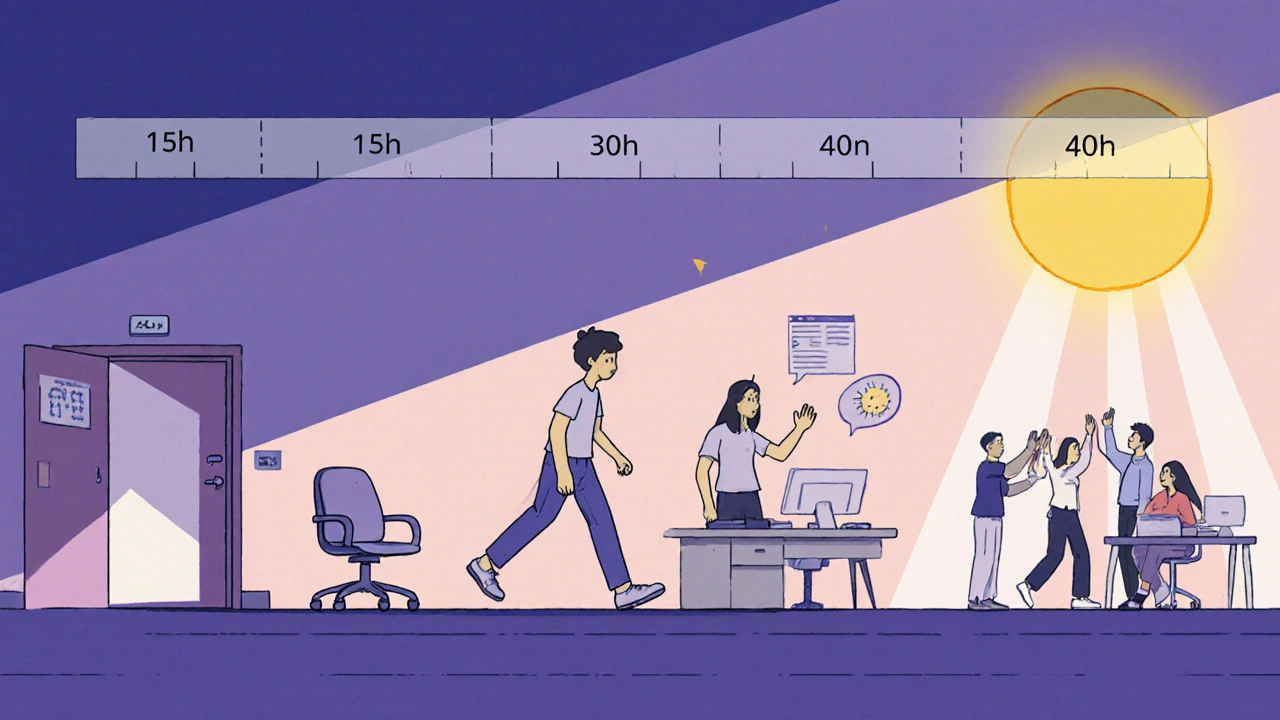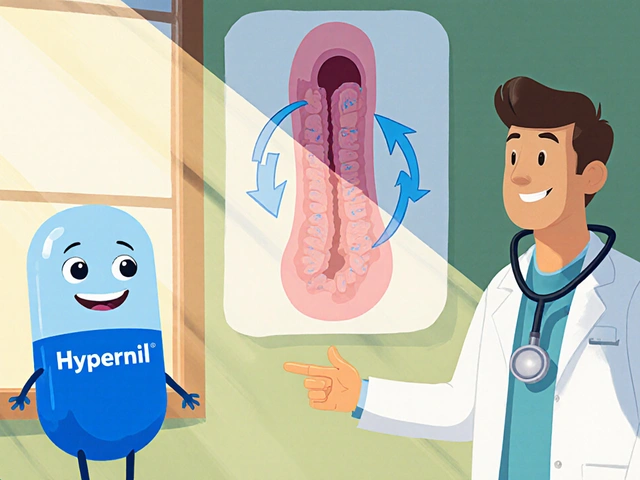Return to Work With Chronic Pain: Practical Accommodations and Step-by-Step Plans

Returning to Work With Chronic Pain Is Possible - Here’s How
If you’re dealing with chronic pain and thinking about going back to work, you’re not alone. More than 50 million adults in the U.S. live with pain that lasts longer than three months. Many of them want to work - but they’re stuck between fear, confusion, and the belief that their body won’t let them. The truth? You can return to work with chronic pain. Not by pushing through the pain, but by making smart, legal, and practical changes to your work environment and schedule.
Employers are legally required to help. Under the Americans with Disabilities Act (ADA), if your chronic pain limits major life activities - like sitting, standing, walking, or concentrating - it counts as a disability. That means your employer must offer reasonable accommodations, unless it causes them serious financial hardship. And here’s the thing: 56% of accommodations cost nothing. The rest? On average, less than $300. That’s not a burden. It’s a smart investment.
What Counts as a Reasonable Accommodation?
Accommodations aren’t luxury perks. They’re tools that let you do your job without making your pain worse. They fall into four main categories: physical, time-based, environmental, and assistive.
- Physical adjustments: An adjustable sit-stand desk (costs $300-$1,200), an ergonomic chair ($200-$1,000), or a cushioned footrest ($25-$150). These aren’t optional - they’re medical necessities for someone with back pain, arthritis, or nerve damage.
- Time-based flexibility: Starting work later to avoid morning stiffness, taking 10-minute breaks every 90 minutes to stretch or walk, or working from home during flare-ups. These aren’t laziness. They’re pain management.
- Environmental changes: Moving your desk closer to the bathroom or elevator if walking more than 100 feet triggers fatigue. Adjusting room temperature if cold or heat makes your pain worse - especially if you have multiple sclerosis or fibromyalgia. Even moving from a second-floor office to ground floor can be life-changing.
- Assistive tech: Voice recognition software ($100-$300) if typing hurts your hands. A heated massage cushion ($85) that plugs into a standard outlet. A keyboard with low-force keys. These aren’t gadgets - they’re prosthetics for your body.
Some accommodations are simple but powerful. One woman with severe spinal stenosis couldn’t sit for more than 20 minutes. Her solution? A standing desk, a stool to rest on during calls, and a 5-minute walk every hour. She’s been working full-time for three years now.
How to Ask for Accommodations - Without Getting Pushed Back
Asking for help is the hardest part. Sixty-two percent of people with chronic pain delay asking because they fear being seen as weak, lazy, or replaceable. But silence doesn’t protect you - it hurts you more.
Here’s how to do it right:
- Get documentation from your doctor. It doesn’t need to be a novel. Just a note that says: “Patient has chronic lower back pain due to degenerative disc disease. Functional limitations include difficulty sitting >30 minutes, need for frequent position changes, and requirement for ergonomic seating.” That’s enough.
- Put it in writing. Email your manager or HR. Say: “I’m returning to work after medical leave and need reasonable accommodations under the ADA. My doctor has provided documentation. I’d like to discuss options like a sit-stand desk and 10-minute breaks every 90 minutes to manage my pain.” Don’t apologize. Don’t over-explain. Just state it clearly.
- Be specific. Vague requests like “I need help with my pain” get ignored. Specific ones like “I need a cushioned seat insert that costs $75 and fits my current chair” get approved. One study found vagueness increases denial rates by 55%.
- Know your rights. Your employer can’t force you to accept a specific accommodation. They have to work with you to find one that works. If they say no, ask why. If they say it’s too expensive, ask for a cost estimate. The Job Accommodation Network (JAN) offers free help to both employees and employers - call them before you panic.
Federal employees have it easier. Their process is standardized, and 87% of requests are approved within 14 days. Private sector workers? It’s messier. But you still have rights. If your company has 15 or more employees, the ADA applies. In California? Even if they have just 5 employees, you’re protected.

What If They Say No?
Denials happen. But they’re often based on misunderstanding, not malice.
Common reasons employers say no:
- “We don’t have the budget.” But 56% of accommodations cost nothing. A standing desk? $300. A flexible schedule? $0.
- “We can’t change how things are done.” But if your job is typing, and typing hurts your wrists - changing the keyboard isn’t changing the job. It’s enabling it.
- “This is temporary.” Chronic pain isn’t a cold. It doesn’t go away in two weeks. But 41% of denials come from this myth.
If you’re denied, don’t give up. Ask for the reason in writing. Then contact the Job Accommodation Network (JAN). They’ve helped resolve 82% of cases without lawsuits. They’ll help you draft a better request. They’ll even talk to your employer for you.
And if your employer still refuses? You can file a complaint with the Equal Employment Opportunity Commission (EEOC). But most people don’t need to go that far. Often, just knowing you know your rights changes the conversation.
Gradual Return: Start Small, Stay Strong
Going back full-time right away? That’s how people end up back on leave. The smartest approach is a graduated return.
Instead of jumping from 0 to 40 hours a week, start at 20 or 30. Work three days a week. Do half-days. Use your accommodations from day one. This gives your body time to adjust, and your employer time to see you’re still productive.
Research shows people who return gradually are 63% more likely to stay employed long-term than those who go back full-time immediately. One man with complex regional pain syndrome started at 15 hours a week. After six months, he was at 30. After a year, he was full-time - and pain-free for longer stretches than he’d been in five years.
Track your progress. Note which accommodations help. Which days are easier? What time of day do you feel best? Share that data with your doctor and employer. It turns your experience into evidence.

Why Coworkers and Supervisors Matter More Than You Think
Accommodations don’t work in a vacuum. If your boss is skeptical, or your team doesn’t understand, even the best desk won’t help.
Studies show employees with strong relationships at work are 2.3 times more likely to get accommodations approved. Why? Because people help people they trust. If your manager sees you as reliable, they’re more willing to bend rules. If your coworkers understand your pain isn’t “all in your head,” they’re more likely to cover for you during a flare-up.
One simple trick: Share a short, honest update. Not a diagnosis dump. Just: “I’ve been managing chronic pain, and some days I need to move around more or take a short break. It helps me stay focused and productive. Thanks for your support.” That’s enough. Most people will respond with respect.
Supervisor training matters too. Companies that train managers on chronic pain see 23% higher return-to-work rates. If your company doesn’t offer it, ask if they’ll bring in a speaker from JAN or a local occupational therapist.
What’s New in 2025: Long COVID and Wearable Tech
Chronic pain isn’t just from old injuries. Long COVID has created a whole new wave of people needing accommodations. The EEOC confirmed in 2021 that long COVID can qualify as a disability under the ADA - and that’s still true today.
Also emerging: wearable tech. Some employees are using devices that track movement, heart rate, and muscle tension to objectively show when pain limits their function. Right now, only 7% of accommodations use this data - but it’s growing fast. If your pain is invisible, this could be your strongest tool.
And there’s movement in policy. The Department of Labor’s Return to Work Initiative, launched in 2023, is funding state programs to create standardized RTW plans. In Alberta and Ontario, pilot programs are already testing digital accommodation trackers. Canada is watching closely.
Final Tip: Don’t Wait Until You’re Broken
Too many people wait until they’re in so much pain they can’t work at all. Then they panic. Then they get stuck.
The best time to plan for return is before you leave. Talk to your doctor. Write down what you need. Practice explaining it. Know your rights. Talk to HR before your last day off.
Chronic pain doesn’t mean the end of your career. It means you need to work smarter. The system is built to help you - if you know how to use it.
Can my employer fire me for having chronic pain?
No. Under the ADA and similar laws, firing someone because of chronic pain - without trying to provide reasonable accommodations - is illegal discrimination. Your employer must engage in an interactive process to find a solution. If they terminate you after you request accommodations, you may have grounds for a legal claim. Document everything.
Do I have to tell my boss I have chronic pain?
You don’t have to disclose your diagnosis, but you do need to explain your functional limitations to qualify for accommodations. You can say: “I have a medical condition that affects my ability to sit for long periods,” without saying “I have fibromyalgia.” The focus is on what you need to do your job, not your medical label.
What if my job requires standing all day?
Even jobs that require standing can be adapted. You can request an anti-fatigue mat, a stool to rest on during breaks, or a shift rotation that allows you to alternate between standing and sitting. If you have a condition like arthritis or neuropathy, your doctor can document that prolonged standing worsens your symptoms. Employers must explore alternatives - even if it means reassigning minor tasks.
Can I get accommodations if I work remotely?
Yes. Remote workers have the same rights. You can request an ergonomic chair, a standing desk for your home office, voice-to-text software, or flexible hours to attend medical appointments. Your home workspace is part of your work environment under the ADA. Your employer may need to reimburse you for equipment up to a reasonable amount.
How long does the accommodation process take?
Federal agencies must respond within 10 business days. Private employers don’t have a strict deadline, but they must respond promptly. If you haven’t heard back in two weeks, follow up in writing. If they delay without reason, contact the Job Accommodation Network (JAN). They can help you push back without escalating to legal action.
Are there free resources to help me request accommodations?
Yes. The Job Accommodation Network (JAN) offers free, confidential advice for employees and employers. They provide sample request letters, accommodation ideas, and even call employers on your behalf. Visit askjan.org or call 1-800-526-7234. They’ve helped over 100,000 people since 1992.






Andrew Forthmuller
November 14, 2025 AT 13:07Elizabeth Buján
November 16, 2025 AT 00:56Mark Rutkowski
November 17, 2025 AT 07:36manish kumar
November 17, 2025 AT 18:17Benjamin Stöffler
November 18, 2025 AT 15:23Ryan Everhart
November 19, 2025 AT 01:36Arpita Shukla
November 20, 2025 AT 06:36Alex Ramos
November 21, 2025 AT 18:09David Barry
November 22, 2025 AT 11:44vanessa k
November 22, 2025 AT 18:19Alyssa Lopez
November 24, 2025 AT 15:38edgar popa
November 26, 2025 AT 03:33Eve Miller
November 27, 2025 AT 00:25Nicole M
November 27, 2025 AT 20:30Chrisna Bronkhorst
November 29, 2025 AT 10:58